Discover 11 hidden attractions, cool sights, and unusual things to do in Bergama (Turkey). Don't miss out on these must-see attractions: Library of Pergamum, Asclepeion, and Red Basilica. Also, be sure to include Bergama Museum in your itinerary.
Below, you can find the list of the most amazing places you should visit in Bergama (Izmir).
Table of Contents
Library of Pergamum
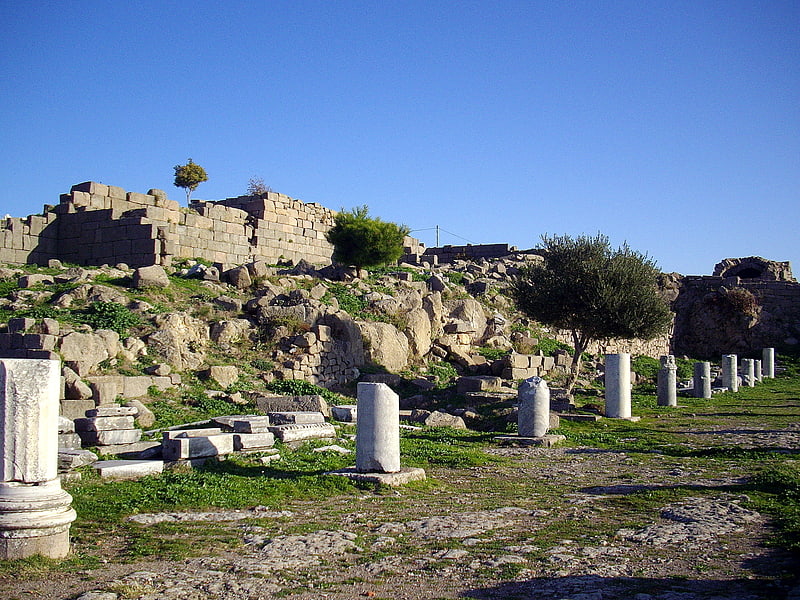
The Library of Pergamum in Pergamum, Turkey, was one of the most important libraries in the ancient world.[1]
Asclepeion
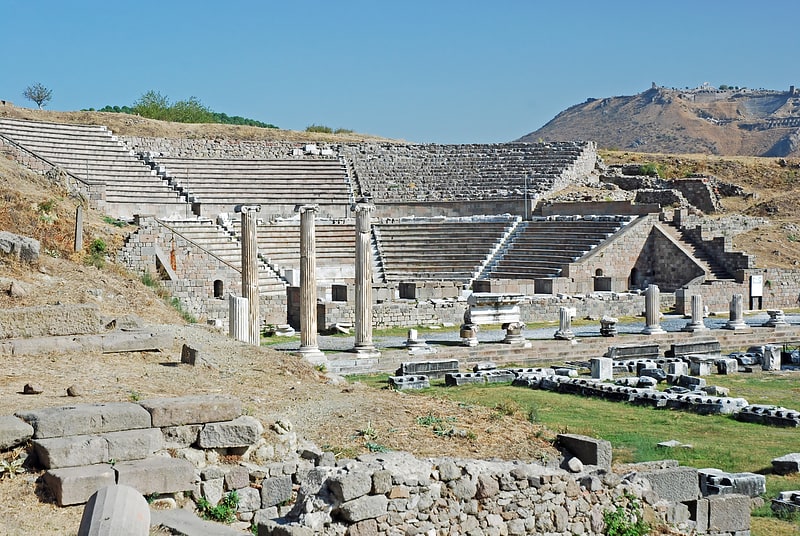
Also known as: Asklepion
Asclepeions were healing temples located in ancient Greece, dedicated to Asclepius, the first doctor-demigod in Greek mythology. Asclepius was said to have been such a skilled doctor that he could even raise people from the dead. So stemming from the myth of his great healing powers, pilgrims would flock to temples built in his honor in order to seek spiritual and physical healing.
Asclepeions included carefully controlled spaces conducive to healing and fulfilled several of the requirements of institutions created for healing. Treatment at these temples largely centered around promoting healthy lifestyles, with a particular emphasis on a person's spiritual needs. Characteristic of the Asclepeion was the practice of incubatio, also known as 'temple sleep.' This was a process by which patients would go to sleep in the temple with the expectation that they would be visited by Asclepius himself or one of his healing children in their dream. During this time, they would be told what it is that they needed to do in order to cure their ailment. At the very least, they would wake up having not been directly visited by a deity and instead report their dream to a priest. The priest would then interpret the dream and prescribe a cure, often a visit to the baths or a gymnasium. The preliminary treatment for admission into the Asclepions was catharsis, or purification. It consisted of a series of cleansing baths and purgations, accompanied by a cleansing diet, which lasted several days.
Despite these methods being regarded as ‘faith healing,’ they were highly effective, as is evident by the numerous written accounts by patients attesting to their healing and providing detailed accounts of their cure. In the Asclepeion of Epidaurus, three large marble boards dated to 350 BC preserve the names, case histories, complaints, and cures of about 70 patients who came to the temple with a problem and shed it there. Some of the surgical cures listed, such as the opening of an abdominal abscess or the removal of traumatic foreign material, are realistic enough to have taken place, with the patient in a dream-like state of induced sleep known as "enkoimesis" (Greek: ἐγκοίμησις), not unlike anesthesia, induced with the help of soporific substances such as opium.
Asclepeions also became home to future physicians as well. Hippocrates is said to have received his medical training at an asclepeion on the isle of Kos. Prior to becoming the personal physician to the Roman Emperor Marcus Aurelius, Galen treated and studied at the famed asclepeion at Pergamon.[2]
Red Basilica
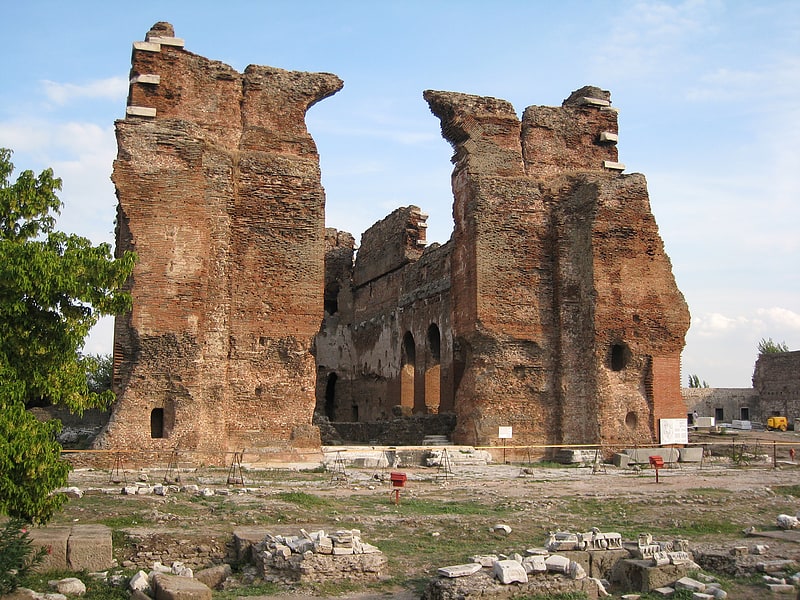
Also known as: Kızıl Avlu
Historical place in Bergama, Turkey. The "Red Basilica", also called variously the Red Hall and Red Courtyard, is a monumental ruined temple in the ancient city of Pergamon, now Bergama, in western Turkey. The temple was built during the Roman Empire, probably in the time of Hadrian and possibly on his orders. It is one of the largest Roman structures still surviving in the ancient Greek world. The temple is thought to have been used for the worship of Egyptian gods – specifically Isis and/or Serapis, and possibly also Osiris, Harpocrates and other lesser gods, who may have been worshipped in a pair of drum-shaped rotundas, both of which are virtually intact, alongside the main temple.
Although the building itself is of an immense size, it was only one part of a much larger sacred complex, surrounded by high walls, that dwarfed even the colossal Temple of Jupiter in Baalbek. The entire complex was built directly over the River Selinus in a remarkable feat of engineering that involved the construction of an immense bridge 196 metres (643 ft) wide to channel the river through two channels under the temple. The Pergamon Bridge still stands today, supporting modern buildings and even vehicle traffic. A series of tunnels and chambers lies under the main temple, connecting it with the side rotundas and giving private access to different areas of the complex. Various drains, water channels and basins are located in, around and under the main temple and may have been used for symbolic reenactments of the flooding of the Nile.
The temple was converted by the Romans into a Christian church dedicated to St John but was subsequently destroyed. Today the ruins of the main temple and one of the side rotundas can be visited, while the other side rotunda is still in use as a small mosque.[3]
Bergama Museum
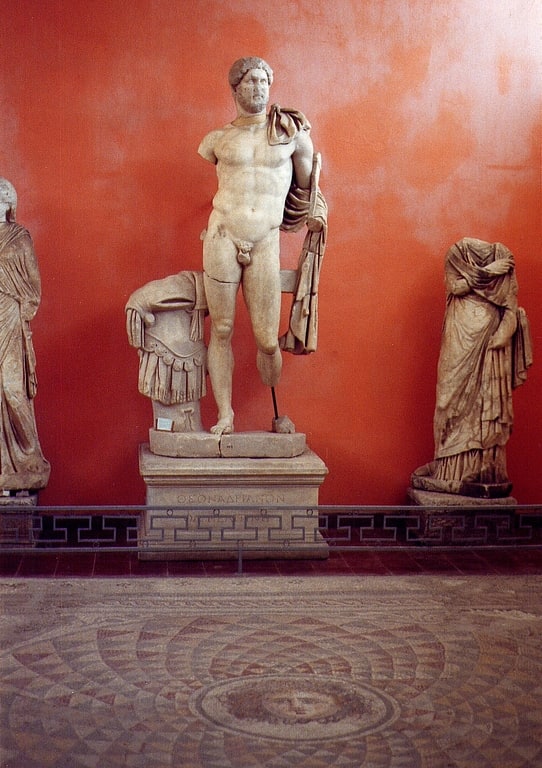
Also known as: Bergama Müzesi
Museum in Bergama, Turkey. Bergama Museum is a museum in Bergama district of İzmir Province, Turkey.[4]
Address: Izmir Cad. No:10/A, 35725 Bergama
Pergamon
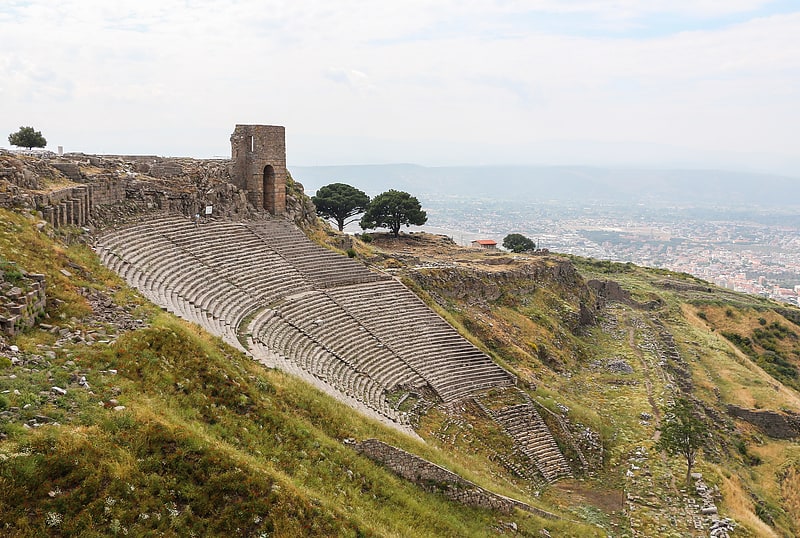
City in Turkey. Pergamon or Pergamum, also referred to by its modern Greek form Pergamos, was a rich and powerful ancient Greek city in Mysia. It is located 26 kilometres from the modern coastline of the Aegean Sea on a promontory on the north side of the river Caicus and northwest of the modern city of Bergama, Turkey.
During the Hellenistic period, it became the capital of the Kingdom of Pergamon in 281–133 BC under the Attalid dynasty, who transformed it into one of the major cultural centres of the Greek world. Many remains of its monuments can still be seen and especially the masterpiece of the Pergamon Altar. Pergamon was the northernmost of the seven churches of Asia cited in the New Testament Book of Revelation.
The city is centered on a 335-metre-high (1,099 ft) mesa of andesite which formed its acropolis. This mesa falls away sharply on the north, west, and east sides, but three natural terraces on the south side provide a route up to the top. To the west of the acropolis, the Selinus River (modern Bergamaçay) flows through the city, while the Ketios river (modern Kestelçay) passes by to the east.
Pergamon was added to the UNESCO World Heritage List in 2014.[5]
Pergamon Bridge
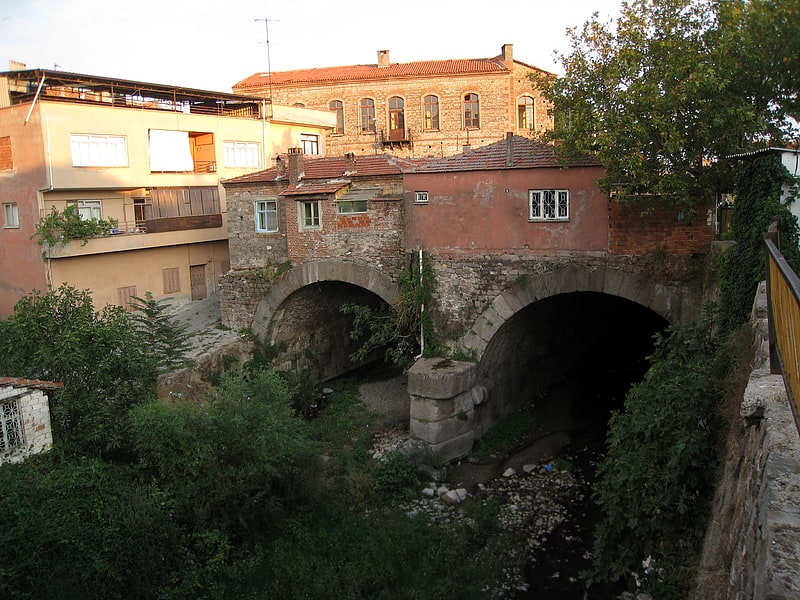
Also known as: Bodrum Köprüsü
Arch bridge in Turkey. The Pergamon Bridge is a Roman substruction bridge over the Selinus river in the ancient city of Pergamon, modern-day Turkey. The 196 m wide structure, the largest of its kind in antiquity, was designed during Hadrian's reign in order to form a passageway underneath a large court in front of the monumental "Red Basilica" temple complex. The two intact tubes, which consist of supporting walls covered with barrel vaults, still serve their purpose to this day.[6]
Kestel Dam
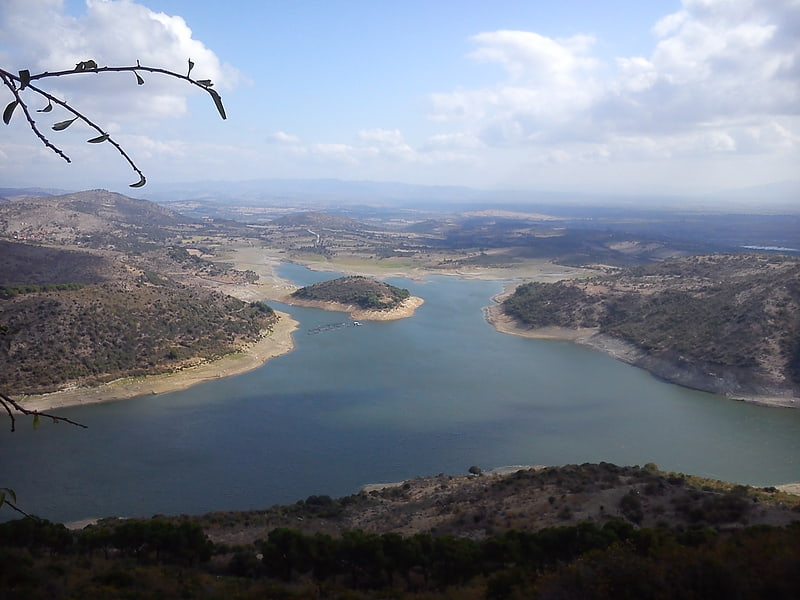
Also known as: Kestel Barajı
Scenic spot in Turkey. Kestel Dam is a dam in Izmir Province, Turkey, built between 1983 and 1988. The development was backed by the Turkish State Hydraulic Works.[7]
Bergamalı Kadri Eğitim Tarihi Müzesi
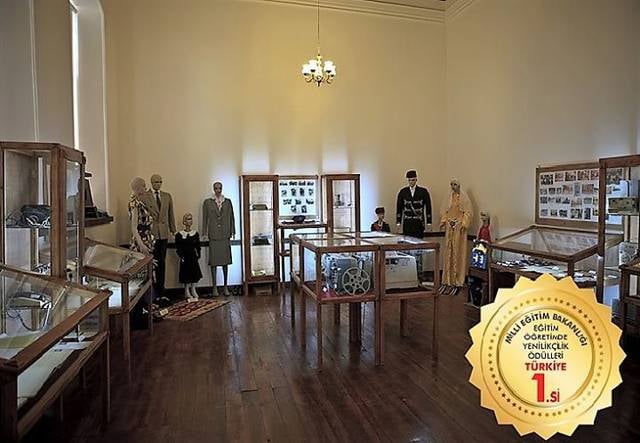
Specialty museum, History museum, Museum
Address: Talatpasa Mah. Dede Sok. No: 39, Bergama
Pergamon
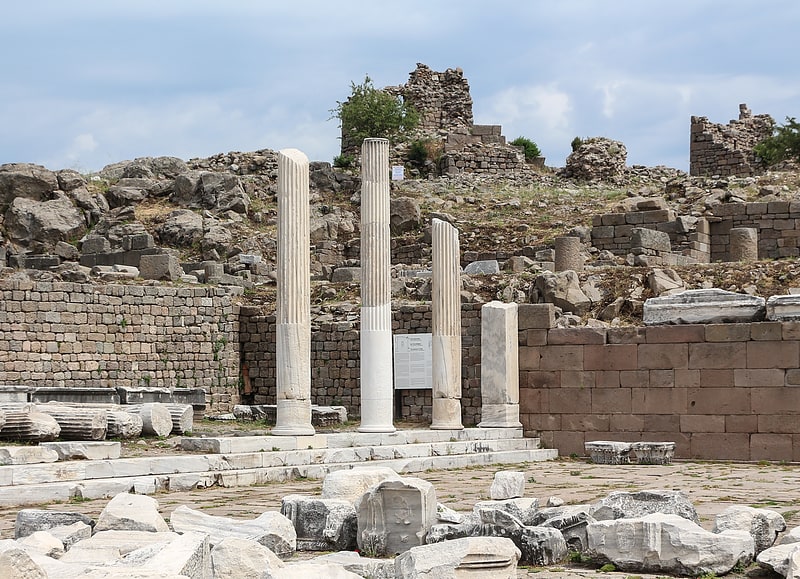
Pergamon or Pergamum, also referred to by its modern Greek form Pergamos, was a rich and powerful ancient Greek city in Mysia. It is located 26 kilometres from the modern coastline of the Aegean Sea on a promontory on the north side of the river Caicus and northwest of the modern city of Bergama, Turkey.
During the Hellenistic period, it became the capital of the Kingdom of Pergamon in 281–133 BC under the Attalid dynasty, who transformed it into one of the major cultural centres of the Greek world. Many remains of its monuments can still be seen and especially the masterpiece of the Pergamon Altar. Pergamon was the northernmost of the seven churches of Asia cited in the New Testament Book of Revelation.
The city is centered on a 335-metre-high (1,099 ft) mesa of andesite which formed its acropolis. This mesa falls away sharply on the north, west, and east sides, but three natural terraces on the south side provide a route up to the top. To the west of the acropolis, the Selinus River (modern Bergamaçay) flows through the city, while the Ketios river (modern Kestelçay) passes by to the east.
Pergamon was added to the UNESCO World Heritage List in 2014.[8]
Bergama Acropolis Gondola

The Bergama Acropolis Gondola is a two-station aerial lift of gondola type at Bergama district of İzmir Province in western Turkey serving the nearby archaeological site of Acropolis. The 700 m long line is operated by Akropolis Teleferik Inc.
Bergama is the site of ancient Pergamon, a major tourist attraction place. A project was worked out in 2005 to connect the site Asclepium down in the valley with the 3 km (1.9 mi) far Acropolis on the top of a steep hill north of Bergama by an aerial lift line. After rejection of this project by the responsible official body due to concerns over the conservation of the historical place, an alternate project for a much shorter route between Acropolis and its foothill north of the town found acceptance in 2006. Access to Acropolis on the narrow road by bus takes considerable time for the tourists, and any widening of the existing road is not permitted due to the archaeological status of the site.
The gondola lift was constructed by the Italian company Leitner Ropeways of Leitner Group costing €6 million, and financed by the local Turkish company Akropolis Teleferik Inc. on the build–operate–transfer base for a lease term of 49 years.
The gondola lift line is 700 m (2,300 ft) long with two supporting towers between the terminals. It started to operate mid May 2010, with the official opening taking place on October 14, 2010. The number of cabins each eight-seater was increased from initially nine to fifteen in 2013. The gondola lift transported with nine cabins hourly up to 1,200 people between the base station at 90 m (300 ft) above sea level and the 330 m (1,080 ft) high end station. The ride takes less than four minutes. The fare decreased from ₺10.00 to ₺8.00 with effect of October 2013.
The development of the number passengers in relation with the number of visitors at the site is shown in the table below:
†) in 2,5 months only.[9]
Bergama İlçe Milli Eğitim Müdürlüğü
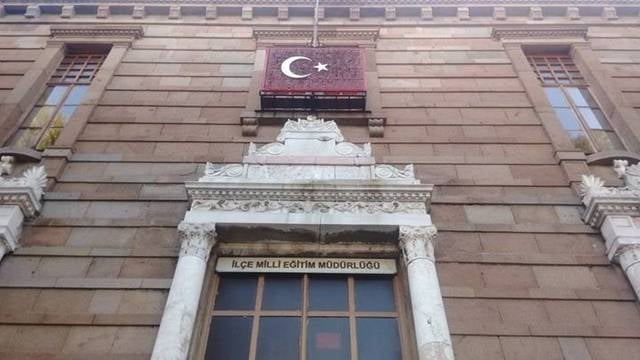
Address: Cumhuriyet Caddesi, Bergama